Importance of Aircraft Health Monitoring
The effectiveness of flights and passenger safety both depend on aircraft health monitoring. Regularly checking the aircraft’s condition enables possible problems to be detected early on, averting unplanned malfunctions while in flight. By properly scheduling maintenance activities in advance, airlines may minimize interruptions to flight schedules. Long-term cost savings can also result from implementing aircraft health monitoring since it can prevent major repairs and increase overall flying safety.
What is Aircraft Health Monitoring?
Systems continuously assesses an aircraft’s state while it is in flight. It collects data from sensors on the engine, structure, and systems of the aircraft. By identifying possible problems before they become serious ones, this data helps to ensure that flying the aircraft is safe.
Common Signs That Indicate Your Plane Needs Monitoring
It is essential to monitor the condition of your aircraft in order to guarantee safety. The following are typical indicators that your plane needs to be watched: Unusual vibrations during takeoff or landing, oil leaks beneath the aircraft, strange noises made during the flight, and inconsistent fuel or oil pressures. By keeping an eye out for these indicators, you can keep your aircraft operating at peak efficiency and take quick action when necessary.
Benefits of Regular Aircraft Inspections
Maintaining your aircraft’s condition on a regular basis will assist avert such problems before they worsen. You can protect your aircraft, increase its lifespan, and save on costly maintenance down the road by doing routine aircraft health inspections. Additionally, it enables you to identify any problems early on, which could ultimately save you time and money. Maintaining your aircraft’s overall performance and efficiency requires routine inspections.
How Aircraft Inspections Improves Safety
Aircraft inspections can help prevent potential issues with planes, ensuring the safety of passengers and crew. Here are a few ways this technology enhances safety:
- Continuous Monitoring:
- Constantly checks the plane’s condition for any abnormalities during flight.
- Early Detection:
- Identifies problems early on, allowing for timely maintenance and repairs.
- Preventive Measures:
- Enables proactive actions to be taken to prevent serious malfunctions.
- Enhanced Communication:
- Facilitates communication between the aircraft and ground crew for immediate action.
- Real-time Analysis:
- Provides real-time data analysis to ensure prompt responses to any potential threats.




